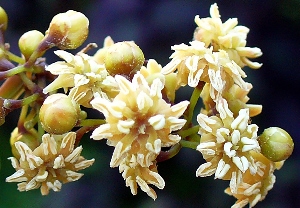
Male flowers of Amborella trichopoda. Photo courtesy of Wertheim Conservatory, Florida International University, Miami.
NC State scientists had a hand in a massive research project highlighted in Science that sheds light on how flowering plants suddenly came into prominence more than 200 million years ago – what Charles Darwin referred to as an “abominable mystery” of evolution.
A team of scientists sequenced the genome of Amborella trichopoda, a rare plant from a South Pacific island that can trace its lineage back to the last common ancestor of all flowering plants, including food crops like tomatoes, apples and legumes, as well as hardwood trees such as oak and poplar.
Lead researcher Claude dePamphilis of Penn State asked experts with NC State’s Forest Biotechnology Group in the College of Natural Resources, led by Vincent Chiang and Ron Sederoff, to analyze Amborella’s cell walls and lignin genes.
More primitive species, such as conifer trees, have only one kind of lignin, the G type, while modern flowering plants have two, Chiang says. Amborella has both types of lignin, S and G, but in an unusual ratio of 1:10, rather than the 2:1 ratio of modern relatives.
“The ratio of lignin in Amborella is not typical for an angiosperm or flowering plant,” Chiang says. “The results indicate that this species is at an early stage of flowering plant evolution.”
In addition to shedding light on Darwin’s mystery, lignin analysis of Amborella could have practical applications.
“Understanding the genome structure of this plant may provide new knowledge about how plants make more S lignin, which is useful to the pulp and paper industry because S lignin degrades more easily,” Chiang says.
NC State scientists made several other interesting discoveries. Amborella contains almost all of the lignin genes – there are 10 lignin families with multiple members. In addition, Amborella has cell walls rich in xylan, a form of hemicellulose that’s dominant in modern flowering plants.
“The results show us that lignin’s evolution in plants may not have been clear cut. In fact, it may have evolved through several stages,” Chiang says.
Taiwan University’s Ting-Feng Yeh, formerly a postdoctoral researcher with Chiang at NC State, did work on cell wall composition. NC State postdoctoral research Jie Liu also contributed to composition analysis. Chiang’s former postdoc Ying Hsuan Sun, now at Taiwan’s National Chung Hsing University, carried out genomic analysis.
“The Amborella genome project provides a new way to study an old and intractable problem because the DNA sequences may reveal secrets of its origins that would not be obvious from more traditional studies of the plant,” Sederoff says.
Read more about the Amborella Genome Sequencing Project>>
This article appeared originally in The Abstract.
 For the third straight year attendance at North Carolina state parks and state recreation areas hovered at a record level with 14.2 million visits. Travelers spent an average of $23.56 per day to enjoy the parks. And the total economic impact of the state parks system is more than $400 million.
For the third straight year attendance at North Carolina state parks and state recreation areas hovered at a record level with 14.2 million visits. Travelers spent an average of $23.56 per day to enjoy the parks. And the total economic impact of the state parks system is more than $400 million.





